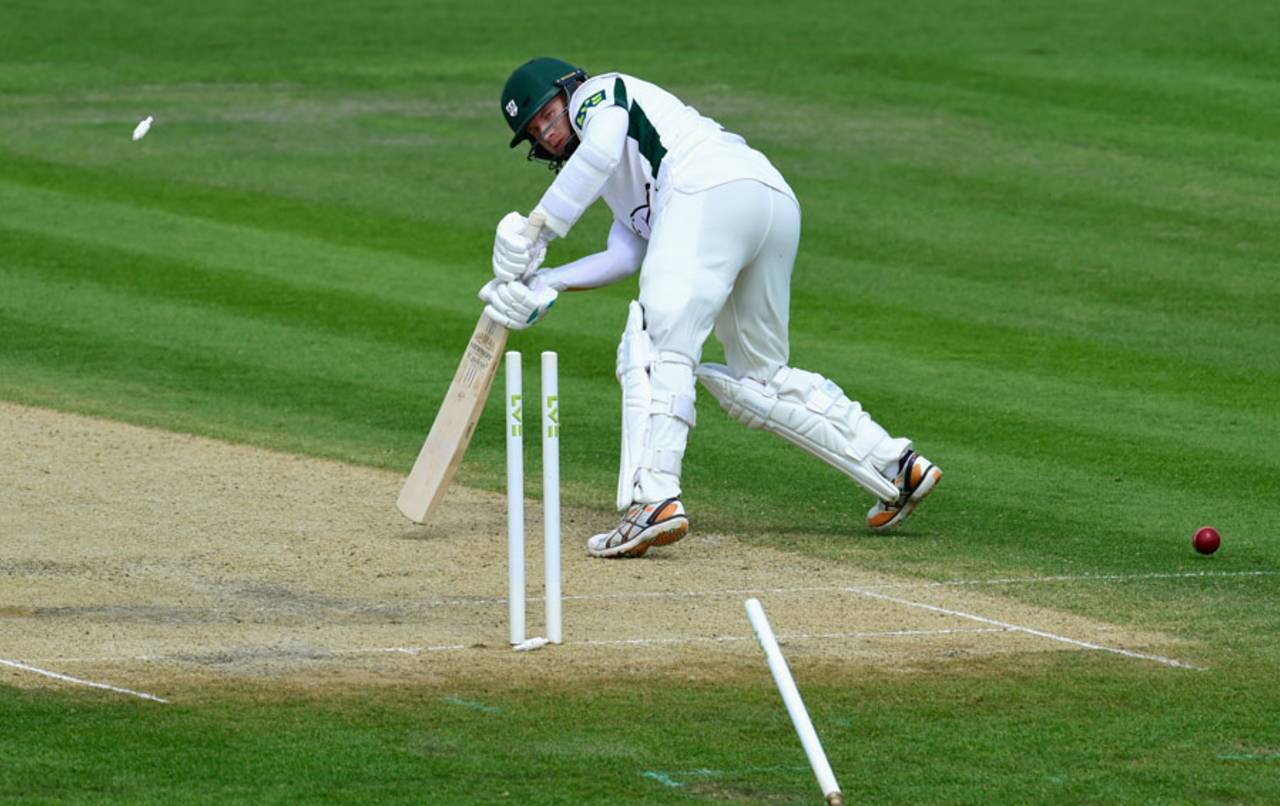Long hop or peach?
A ball can be both; it all depends on how you look at it
Jonathan Wilson
23-Jun-2015

Schrodinger's ball: a straight delivery can be two things • Getty Images
Something it took me a long time to understand about cricket was that almost everything is relative. It didn't seem to make sense to me that when a West Indies quick was bowling short, it was worthy of praise, even terror, and had batsmen hopping around, but when some English seamer did it, it was bad and tended to be beleaguered square of the wicket for four.
Part, of that, of course was the commentators' need for explanation. This is true across all sports: nothing can ever just be. If a bowler bowled a ball on middle and leg and the batsman missed it, he was getting due reward for aiming at the stumps: "You miss and I'll hit". But if it was worked into the leg side, the bowler was guilty of bowling "too straight". And of course if the batsman had missed it, he'd be guilty of having "played across the line", an offence I was aware was extremely grave long before I knew what it meant.
My great breakthrough in trying to comprehend football tactics was that, as the Swiss semiotician Ferdinand de Saussure observed of language, everything is dependent on something else. We can draw general rules because certain aspects tend to stay the same, but there are almost no absolutes. It's becoming increasingly clear that the same is true of cricket. A bad ball in one circumstance can be a good ball in another.
Maybe this is obvious to people who have played a lot of the game, but I came late to cricket and the learning curve is steep. I barely played at school, dabbled at university, and after I left I'd get maybe three or four games a season for five years or so after I left, and then drifted away. Only a chance meeting at The Oval the summer before last led me to taking it up again. I'd never had a second's coaching until this winter, when I started going to Surrey's Friday evening sessions.
Over the past year, having read between the lines of some comments from my captain about my scoring rate and the way the modern game has
moved on from nudging and nurdling, I've tried to convert myself into an offspinner. I've taken to running four miles from home to some public nets, bowling 30 overs at a railway sleeper - 20 sets of nine balls, two of which have to be bowled to a notional left-hander - and running home again. It's oddly therapeutic.
I bowl slowly anyway, but two paces into my four-pace run-up I decided this was going to be the slowest of all balls
I'm a thousand times better than I was, which is to say still not very good, but maybe five or six out of every nine balls go vaguely where I want them to. I have two deliveries now: a straight one that bounces a bit and a straight one that doesn't. I have become good at two things, though: I can flick the ball from one hand to the other at the start of my run-up in a manner than suggests competence and, while not wishing to be immodest, I appeal exceptionally. I have volume, emotional depth and variety - I can do both hands up, leaning backwards, and down on one knee, pointing with my left hand.
It was in a game at Eton that the theory of relativity struck me. I'd taken a wicket with my first ball, the one that bounces a bit, taking a top edge through to the keeper. The new batsman was starting to get on top of me, though, and clubbed me for a six over midwicket. I fully expected to be taken off, but the captain let me have one more over. I pushed the first ball down the leg side - accidentally; he swiped and missed and the ball dollied into his pads. Then it came, the moment of clarity.
It was clear that he was frustrated, obvious that he was going to try to repeat that hoick over midwicket. At the start of my run-up, I thought, for little obvious reason, of Antonin Panenka, the Czechoslovak midfielder famous for having scored the winning penalty in the 1976 European Championship final by dinking it slowly down the middle as the West Germany goalkeeper Sepp Maier dived out of the way. The key, Panenka later said, was to hit the ball so slowly that the keeper's momentum had taken him out of the way long before the ball arrived. A soft chip hit too hard risked the keeper sticking out a hand or a leg as he dived and still making a save.
I bowl slowly anyway, but two paces into my four-pace run-up I decided this was going to be the slowest of all balls. This was my Panenka. As
soon as it left my fingers, I knew I had him. Several seconds later, the batsman having played so early he could almost have had a second
swing at it, the ball, dipping towards its second bounce, nestled against leg stump. It was so slow only one bail was dislodged.
"Another wicket with a long hop," moaned mid-off, who had charged through six quick, accurate overs with the new ball for the paltry reward of a single wicket. I decided it wasn't the time to explain the Panenka, although I'm led to believe I've done so repeatedly since, after finishing with figures of 4 for 35.
A long hop isn't always a long hop. Everything's relative.
Jonathan Wilson writes for the Guardian, the National, Sports Illustrated, World Soccer and Fox. @jonawils